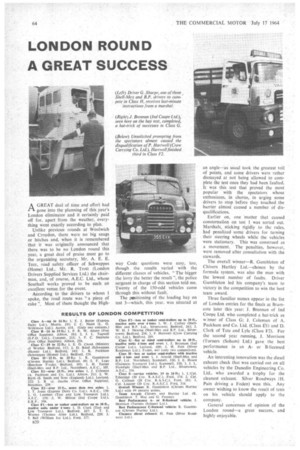LONDON ROUND A GREAT SUCCESS
Page 66

If you've noticed an error in this article please click here to report it so we can fix it.
AGREAT deal of time and effort had gone into the planning of this year's London eliminator and it certainly paid off for, apart from the weather, everything went exactly according to plan.
Unlike previous rounds at Woolwich and Croydon, there were no big snags or hitches and, when it is remembered that it was originally announced that there was to be no London round this year, a great deal of praise must go to the organizing secretary, Mr. A. E. E. Teer, road safety officer of Schweppes (Home) Ltd., Mr. R. Trott (London Drivers Supplied Services Ltd.) the chairman, and, of course, A.E.C. Ltd., whose Southall works proved to be such an excellent venue for the event.
According to the drivers to whom I spoke, the road route was "a piece of cake". Most of them thought the High way Code questions were easy, too, though the results varied with the different classes of vehicles. "The bigger the lorry the better the result ", the police sergeant in charge of this section told me. Twenty of the 150-odd vehicles came through this without fault.
The positioning of the loading bay on test 3—which, this year, was situated at an angle—as usual took the greatest toll of points, and some drivers were rather dismayed at not being allowed to complete the test once they had been faulted. It was this test that proved the most popular with the spectators whose enthusiasm, in chorus, in urging some drivers to stop before they touched, the barrier almost caused a number of disqualifications, Earlier on, one matter that caused consternation on test Iwas sorted out.
Marshals, sticking rigidly to the rules, had penalized some drivers for turning their steering wheels while the vehicles were stationary. This was construed as a movement. The penalties, however, were removed after consultation with the stewards.
The overall winner—R. Gumbleton of Chivers Hartley Ltd.—chosen by the formula system, was also the man with the lowest number of faults. Driver Gumbleton led his company's team to victory in the competition to win the best team award.
Three familiar names appear in the list of London entries for the finals at Bramcote later this year: J. Brennan of Ind Coope Ltd, who completed a hat-trick as w:nner of Class G; J. Coleman of A. Packham and Co. Ltd. (Class JE'l) and D. Clark of Tate and Lyle (Class F2). For the second year running, J. Morrison (Turners (Soham) Ltd.) gave the best performance in an Aor B-licensed vehicle.
An interesting innovation was the diesel exhaust check that was carried out on all vehicles by the Dunedin Engineering Co. Ltd., who awarded a trophy for the cleanest exhaust. Silver Roadways (H. Pain driving a Foden) won this. Any owner wishing to know the result of tests on his vehicle should apply to the company.
General concensus of opinion of the London round—a great success, and highly enjoyable.
















































































































